
NIKON D5000 FULL
It took some time for Nikon to realise that the full potential of Live View can only be exploited if it is delivered on a hinged screen, but the company has finally joined the ranks of Olympus, Panasonic and Sony in offering a model sporting this feature. This articulated screen is one of the few true novelties the D5000 offers over previous Nikon DSLRs. Enter the info button - pressing it displays virtually all of the camera's main settings on the large rear screen, provided it is not folded inward to protect it from harm. This button is arguably at the heart of the Nikon D5000's ease-of-use, as the camera lacks the monochromatic status LCD of the D90, so Nikon had to provide a different way to check vital shooting information without having to look into the viewfinder.

The other button sitting next to the shutter release, which was dedicated to the Active D-lighting function on the D60, is once again labeled 'info', just like on the old D40. The control wheel is now slightly slanted, making it more ergonomic than on the D60. Hold down this button with your right forefinger and spin the control wheel on the top-rear of the camera with your thumb to adjust its settings - simple and intuitive. The Exposure Compensation button is thoughtfully positioned next to the shutter release. The Nikon D5000 follows conventional DSLR design in having a shooting mode dial on the top of the camera, which allows you to select either one of the advanced modes like Manual, Aperture- or Shutter-priority, or a number of scene modes. This, however, introduces some shutter lag, which usually isn't worth the few decibels of difference versus what is already an impressively quiet shutter (Nikon recommends using the Quiet mode for taking pictures of sleeping babies, a situation in which a bit of shutter delay isn't a problem). The shutter release action on the Nikon D5000 is surprisingly quiet, with an exemplarily dampened mirror slap that makes this DSLR actually quieter than some rangefinder cameras! Furthermore, there is a new Quiet mode, in which the mirror is raised fairly slowly to further reduce the sound it makes. Nikon bodies don't offer any form of in-camera image stabilisation, unlike similar models from Sony, Pentax and Olympus, so the affordable 18-55mm VR lens is a good investment. It also adds the very important advantage of Vibration Reduction. The 18-55mm f/3.5-5.6 VR kit lens that Nikon supplied feels fairly well-balanced - if a tad front-heavy - on the Nikon D5000 and it fits into place with a reassuring mechanical click. New to the D5000 is a rubberised thumb rest on the back of the body, which is a welcome improvement over the D60. The right-hand grip bears more resemblance to that of the D60 - it's a wee bit uncomfortable for photographers with large hands and/or longish fingers, but not annoyingly so. It isn't as compact and lightweight as the D60 but neither is it quite as bulky and heavy as the D90.

The new Nikon D5000 slots in between the existing D60 and D90 models, not only in terms of feature set and functionality, but also in terms of size and weight.


A 4fps burst shooting mode, 11-point autofocus system with 3D Focus Tracking, 100,000-cycle shutter unit, quiet shooting mode, Active D-Lighting and 19 Scene Modes complete the Nikon D5000's headline specs.
NIKON D5000 ISO
A 2.7 inch vari-angle LCD monitor makes it easier to compose your shots from difficult angles, while the extensive ISO range of 100-6400 should cope with most lighting conditions. The Nikon D5000 is a new 12.3 megapixel DSLR camera that can record HD movies at 1280x720 pixels / 30fps with sound.


 0 kommentar(er)
0 kommentar(er)
